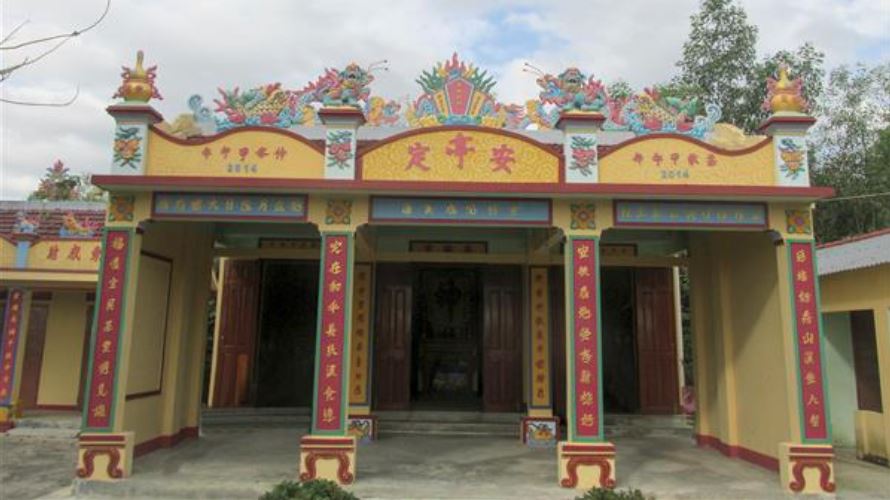Description
The relic is located in An Dinh village, Dien Phuoc commune, Dien Khanh district, Khanh Hoa province (formerly An Dinh commune, Thuong canton, Phuoc Dien district, Dien Khanh district).
Through the study of historical documents, An Dinh communal house was built around the end of the 19th century, to worship Tan Vuong Dai Can Thai Tu, Son Lam Lord general, Tien Hien, Hau Hien… Since its construction, the communal house has experienced many times restored, originally made of bamboo, cork, thatched roof in the land near Danh Thanh village, Dien Loc commune. Then, because of the epidemic, the villagers moved to the land known as Household land, or Cay Dau land, about 1km east of the present communal house. In 1947, the French invaders attacked the village and destroyed the communal house. In 1964, the old dignitaries agreed to move the communal house to its present position. In 2009, the Tien Hien Temple was restored. In 2014, the monument was overhauled.

 An Dinh's Prefab house
An Dinh's Prefab house
An Dinh communal house is located on a flat land, with a campus of 1,196m2, the relic turns to the north, has the following overall layout: Nghi mon, feng shui, communal house yard, sacrifice and main hall, temple Tien sage, Son Lam temple, western house. The works here are arranged in harmony, with the architectural style and decorative patterns bearing typical features of the communal house of Khanh Hoa village.
At present, An Dinh communal house still preserves a lot of valuable artifacts containing great content of history and culture through the periods: Han Nom documents, gongs, drums, bar, vestments... Especially the three ordinations granted by the Nguyen kings to Qin Vuong Dai Can Thai Tu, according to statistics of the Center for Monuments Conservation of Khanh Hoa province, this type of ordination is rare in Khanh Hoa (currently there are two colors). ordained at the temple of Thai Tu, Binh Khanh village, Dien Hoa commune).
Qin Vuong Dai Can Thai Tu was worshiped in the communal house, according to legend as follows:
Crown Prince is the son of King Ba Tranh (former Champa), whose name is unknown. In 1692, Ms. Tranh sent the Crown Prince from Phan Rang to establish his capital at Dong Say (Dien Tan commune area), when the Prince led his army to resist the army of Lord Nguyen led by General Nguyen Huu Canh to occupy Dien Ninh. When the crown prince lost the battle, he tried to run back and entrench at the capital of Dong Say, when he ran through Am Phu mound, he was martyred at the gate of Truong Xuan Dai.
Legend has it that when the Prince died, a drop of blood splashed on the stone, from which grew a very sacred headless stone statue. The villagers here see that, so they worship the sacred stone statue (Thai Tu temple, Binh Khanh village, Dien Hoa commune).
Every year, on the 16th and 17th of February (lunar calendar), people in the village organize a Spring worship festival bearing the local cultural identity.
An Dinh communal house is one of the relics in Dien Khanh land that was built around the beginning of the 19th century to worship Tan Vuong Dai Can Thai Tu (according to legend, this is the husband of Thien Y Thanh Mau). The relic exists along with the history of formation and development of Dien Khanh land. The communal house is a historical proof that marks a period of land exploration by the ancestors, in which converges almost all the values that his father and grandfather created and handed down.
With the above cultural values, the relic has been classified as a provincial relic by the People's Committee of Khanh Hoa province, issued Decision No. 1059/QD/CT.UBND, dated April 20, 2018.